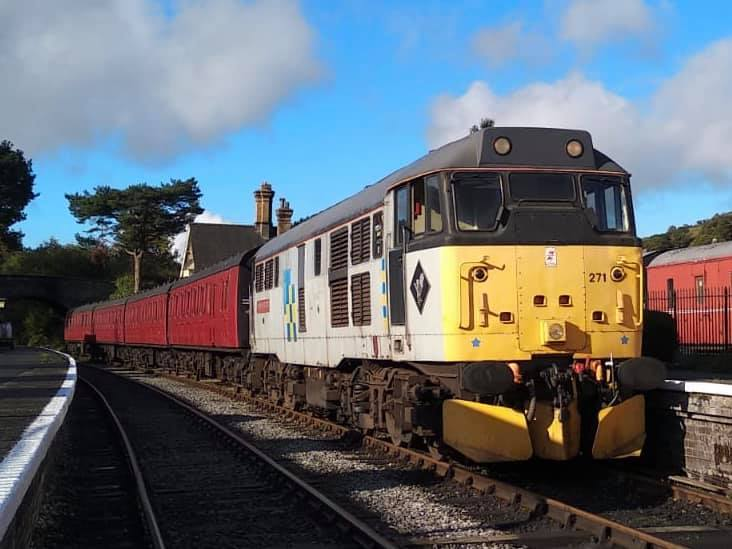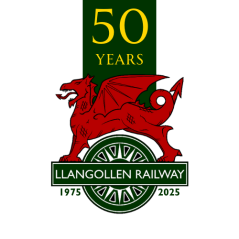MORE INFORMATION ON OUR DIESEL LOCOMOTIVES
OPERATIONAL EX-MAINLINE DIESEL LOCOMOTIVES
| Class 26 |  |
Built by British Railways’ Birmingham Carriage and Wagon Works in 1958, this attractive Class 26 Diesel started its life pulling passenger and freight traffic between Glasgow, Edinburgh and Aberdeen. Like others of its class, D5310 would often have been paired with other Class 26 or 24 locomotives to pull heavier passenger services, and was a mainstay of the Scottish Highland lines until the introduction of the Class 37 to the region in the early 1980s. After 1985, the Class 26 was expected to remain a workhorse of the freight sector for at least fifteen years. However, the 1990 Recession and the subsequent scaling-back of British steel manufacturing spelled the end for the Class, and D5310 in particular was removed from traffic when it suffered a serious engine fire in December of 1992. It was acquired for preservation in 1995 and restored by the efforts of the Northampton & Lamport and Great Central Railways, before eventually moving to Llangollen in 2009. Since then, D5310 has been proven a popular and reliable engine. In spite of being over sixty years old, it has one of the highest rates of availability on our railway and handles our services in all weathers very well indeed. Most recently overhauled in 2020 by the Gloucester and Warwickshire Railway, D5310 has also been hired to a number of other railways for Galas, and visits the Great Central periodically. |
| Class 31 |  |
After entering traffic in 1961 this engine, like many of its class, was allocated to the British Railways Stratford Depot in London. Class 31s were given a number of ignominious nicknames by BR crews, including ‘Gargoyles’ due to the supposed ugliness of the design, ‘Pedal Cars’ for their comparative lack of torque, ‘Gurglers’ due to the noise of the engine and ‘Skinheads’ for those which lacked the top headcode display. A less mean nickname was ‘Toffee Apples’ for the earlier examples, after the distinctive shape of their main control levers, which had to be carried between cabs as an additional safety feature.
In spite of their apparent ill-favour by crews, a total of 263 Class 31s were produced for the network by Brush Traction, of which D5801 is a ‘Type 2’. The locomotives were developed from an older design intended for the Ceylon Government of modern-day Sri Lanka. Later given a beefier engine capable of developing 1,470hp and going on to produce up to 35,600lbs of pulling power, the engines also boasted an advanced EM control system, allowing two or three units to be controlled from one cab. The distinctive pug-nose shape is due to a door set into the front of each cab to allow a crewman to pass between locos. While useful in theory, this feature was rarely used and mostly served to make the cabs cold and draughty, so many of them were welded shut. Now owned by A1A Locomotives Ltd, this engine is on long-term loan to the Llangollen Railway. It carries the name ‘Stratford 1840-2001’ in honour of its original Depot and sports a grey ‘Trainload Freight’ livery, from the period after 1988 in which British Rail was broken up into distinct sectors for later privatisation. The yellow and blue chequered device on the side denoted an engine belonging to the Construction sector, as opposed to Coal, Metals or Petrochemical. |
| Class 47 |  |
Boasting a 2,580hp Sulzer-type power unit and generating a whopping 62,000lbs of tractive force, this is by far our most powerful engine. Built as D1566 at the British Rail works at Crewe in 1964, this engine’s early allocations were to Sheffield, London and Norwich, hauling heavy freight and occasional passenger services on the East Coast Mainline. After this, the loco was moved back to the North-West, eventually settling at the Crewe Depot in 1973. By this time, BR was introducing its computerised Total Operations Processing System (TOPS), which gave D1566 its new designation of 47449, under which it operated nationwide, particularly on the North Wales coast throughout the 1980s. 47449 returned to Sheffield and then London again in the early ‘90s before being formally withdrawn from public service.
47449 was finally acquired for preservation by noted music producer and train enthusiast Pete Waterman, who used it for some years as a Private Charter before selling it on to Llangollen Diesel Group in 1996. It has since earned the name ‘Orion’ in honour of a sister loco (47083) and has been used for pulling our heavier services, as well as being hired to Alstom Traincare Ltd for driver-training purposes in 2001. |
EX-BR SHUNTING LOCOMOTIVES
| Class 08 |  |
Class 08 Shunters are an icon of British engineering. Starting from 1952 and based on a design from the London Midland and Scottish Railway, a total of 996 of these rugged shunters were built, many of which still operate on the national network to this day.
Built under the original British Railways number 13265, our shunter left the Derby Works in August of 1956 and was delivered to the Duffryn Yard near Port Talbot alongside three others of its class, before moving soon after to Neath and then to Cardiff East Dock in 1957. At Duffryn and Neath, 13265’s days would have been spent preparing freight trains from the local industries, which would then be steam-hauled into England by the heavier ex-GWR engines, while Cardiff would have seen it moving material on and off ships in the labyrinth of lines around the East Moors Steelworks. In 1962, having been renumbered at Swindon Works, D3265 was allocated back to Cardiff. It took up duties at the Cathays Carriage works near the University, shunting coaches in and out of the sheds for maintenance and preparing rakes for the mainline. It then moved to its final home at Cardiff Canton in November of 1964, where it would stay until finally withdrawn in 1983. At the Canton Engine Shed, it also acquired a BR Blue livery with Yellow Ends and the ‘TOPS’ number 08195. After retiring from service in 1983, 08195 served some time on the scrap siding at Cardiff Canton before being acquired for preservation. It’s been a key player at Llangollen Railway, working behind the scenes with our Permanent Way crew while they repair track and maintain the line. It can occasionally be seen pulling the Berwyn Shuttle from Platform 2 and providing our ‘Driver for a Fiver’ attraction. |
| Class 03 |  |
British Railway 200hp 0-6-0 D2162 (Class 03, 03162), built in 1960 at Swindon Locomotive Works. Owned by Wirral Borough Council on long-term loan to Llangollen Railway since 1989. Mechanical and cosmetic overhaul has recently commenced. |
